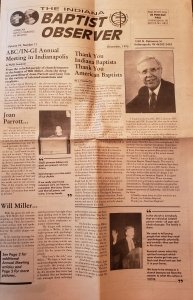Employee Engagement = Vision
It’s a topic that continually comes up in conversation with business leaders. How do I get my employees engaged? How do I keep them engaged? It’s all about vision.
Most people want to be a part of something larger than themselves.
In my video post on LinkedIn last week, I posed the question, “Do you have a vision so compelling that people want to join you on the journey to achieve your vision?”
To me, it’s a fundamental question of leadership.
I believe we all want followers who:
- are engaged
- want to achieve what we want to achieve
- are so fanatical about our shared vision that they spend every day moving toward that vision.
As leaders, we need to learn to paint. Yes, paint.
Start with your vision
You DO have one, right?
Is it aspirational?
Does it serve as a guide for current and future initiatives?
Is it compelling?
Does it go beyond the numbers?
I read a great blog post a few years ago. It was titled something like “Your ROI is Not a Vision”. In it, the author explained why your vision must go beyond the numbers. Profitability, revenue, and EBITDA may get you up in the morning, but for most of your team, that is not what gets them:
- engaged
- excited, or
- up in the morning.
Your employees want something to believe in – something aspirational.
If your vision doesn’t give them that, they will never be fully engaged.
You may need to reexamine your vision…right now.
Learning to paint
You have a vision! Now, you have to communicate it…to everyone… every day.
You have to paint a picture of your vision so compelling that people want to join your company just to be a part of it. Painting this picture takes time – often more time than developing the vision itself.
Let’s play a game of word association. I am going to say (okay, type) a word. I want you to respond with the first word that pops in your head.
Ready?
Ball.
Ok. How many thought “game” or “bat” or “basket” or a “fancy party”? All great “pictures” in our mind’s eyes of a ball. But, we aren’t on the same page.
Let’s try again…
Baseball.
Ok, now what came to mind? “Stadium”, “Cubs”, “Cardinals”? Some may even have thought “boring”. Again, we are closer, but we still have different pictures in mind.
What if we spent time as a group talking about our baseball? It’s brand new. It comes in a box. When we open the box, it is wrapped in that white crinkly paper. The smell of the leather reaches our nostrils.
As we unwrap the ball, the leather is bright white. The red stitching literally pops in contrast. As we run our fingers along the stitches, they feel like a washboard. The leather is soft, but the ball is hard. We see the major league baseball logo, the commissioner’s signature.
Now, when I say “Let’s play ball”, chances are great that we will all see the same image in our minds. That is painting a picture. That is putting your listener or reader into the picture.
I would love to hear from you. What is your vision?
Have you painted a picture for your followers?
Can they see themselves in that picture?
Post a comment, send an email, or give me a call!
I want to hear your stories!


 What makes great leaders great? Is there a moment, an event, that you can point to and say “this is when they became great”, or “this is when they made history”, or even “this is when they became presidential”? Is there a catalyst, an event, where they stand up and lead? Meriwether Lewis was Thomas Jefferson’s secretary, William Clark was hanging out in a cabin in the southern Indiana territory (sorry, I HAVE to throw my heroes in the mix, I know they weren’t presidents), Lincoln was a no-named lawyer from Illinois, Benjamin Harrison played ostrich and stuck his head in the sand for the first two years of the civil war, Roosevelt was considered for the head of street cleaning in New York, and Eisenhower was a mid-level officer primarily known for being a good football coach. What happened? How did they end up in history books? Why are we (read “me”) still talking about them 50, 100, and 200 years later?
What makes great leaders great? Is there a moment, an event, that you can point to and say “this is when they became great”, or “this is when they made history”, or even “this is when they became presidential”? Is there a catalyst, an event, where they stand up and lead? Meriwether Lewis was Thomas Jefferson’s secretary, William Clark was hanging out in a cabin in the southern Indiana territory (sorry, I HAVE to throw my heroes in the mix, I know they weren’t presidents), Lincoln was a no-named lawyer from Illinois, Benjamin Harrison played ostrich and stuck his head in the sand for the first two years of the civil war, Roosevelt was considered for the head of street cleaning in New York, and Eisenhower was a mid-level officer primarily known for being a good football coach. What happened? How did they end up in history books? Why are we (read “me”) still talking about them 50, 100, and 200 years later?


